Sleek, innovative and reduced carbon design tops National Highways gantry competition
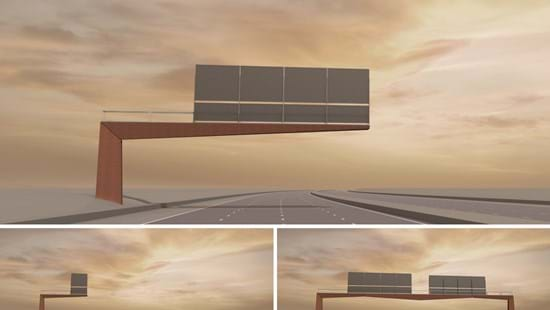
National Highways unveils the winner of a competition for the gantry of the future.
National Highways is today proud to unveil this winning design as part of an exciting competition to create the ‘gantry of the future’ for its motorways and major A-roads.
Millions of drivers see gantries every day as a routine part of their journeys – and probably don’t give them much thought. However, they are vital to providing safe and reliable journeys and giving drivers information they need to reach their destinations.
The competition was organised by National Highways in conjunction with the Royal Institute of British Architects (RIBA), with 32 entries from architectural firms from across the UK and Europe.
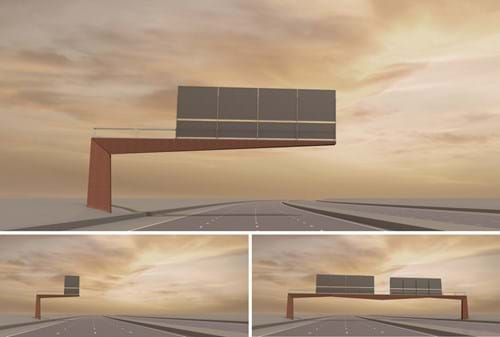
Caption: The winning entry in the gantry of the future competition. When assessed by the judging panel this entry scored highly against key areas of the design requirements; the need for an elegant solution, reduction of carbon, and its potential to produce a cost efficient standardised family of gantries.
The winning entry, created by Useful Studio, features a simple, pared-back design approach. It was chosen by the judging panel for its elegance and simplicity, and how cohesive the design concept was across a range of different structures. As well as a modern look, it will also have less impact on the environment, with a projected reduced carbon footprint compared to current gantries. Useful Studio will now work with National Highways to develop their design concept, with a view to it becoming the standard design for new roads and major upgrades from around two years’ time.
National Highways has been seeking a more streamlined, elegant and consistent visual appearance for roadside gantries to enhance the public’s driving experience. Existing designs tend to be heavily engineered, with an emphasis on function over form.
These changes go hand-in-hand with creating a more efficient standardised structure that also has a reduced carbon footprint, both in terms of the carbon needed for construction and also lower operational and maintenance costs.
The winning entry uses less steel than existing designs, meaning less embodied carbon, and the use of pre-weathered rather than painted steel. The design follows existing best practice from other highways structures and ages better than painted steel, meaning potentially lower maintenance requirements and fewer lane closures and delays for drivers.
It can be adapted for different types of structures including those spanning all carriageways and the roadside signs. We currently have 3,500 gantries, but won’t be immediately replacing structures.
National Highways Executive Director for Operations Duncan Smith said:
“This is a great opportunity for us to develop a more streamlined, elegant, and consistent visual appearance for roadside gantries to enhance drivers’ experience when driving on England’s motorways and Major A-roads.
“Existing designs tend to emphasise function over form, our challenge is to create innovative structures that can accommodate the required signage and equipment that are more sympathetic to the environment.
“In selecting Useful Studio as the winner, the judging panel admired the simplicity and elegance of the pared-back design approach, and the opportunities it presented in terms of a resource efficient, standardised, coherent suite of gantry structures that would be potentially sympathetic to a broad range of settings and contexts.”
Jonathan McDowell, RIBA Architect Adviser said:
“It is very encouraging that National Highways is actively engaging the design community in helping to improve the design of these ubiquitous but cumbersome parts of the motorway experience – we enjoyed seeing a wide range of interesting ideas, including those which challenged National Highways' current practices. The simple and elegant approach of the winning proposal has the potential to greatly improve the appearance and resource-use of these structures, and we look forward to seeing how it is developed and implemented."
Roads Minister Richard Holden said:
"Congratulations to Useful Studio and National Highways for their success in creating a modern, secure design that is set to redefine the look and feel of our motorways and roads.
"Their innovative approach is bound to improve the daily journeys of countless motorists while also contributing to a more sustainable future.”
Although security issues did not form part of the original specification, the new design will be more resilient to trespassers due to entry being concealed within the pillars, making it more difficult to access without authorisation.
Other entries also demonstrated a range of fresh thinking and innovation in approach to the design, including wood composite and LED panel-based designs, as well as identifying the challenge of removing gantries completely in favour of in-vehicle displays.
A design by John McAslan+Partners won second place in the competition and three other concepts were highly commended by the judging panel, which was made up of experts in the architectural and highways fields.
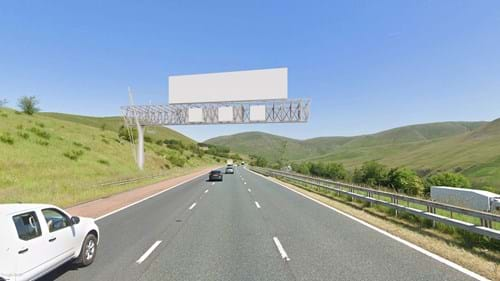
Caption: The second place design. The judging panel admired the clarity and dynamism of the concept, which combined a sculptural primary mast and cable-stayed lightweight modular gantry truss, and its potential to be developed into an elegant family of structures.
The competition is part of National Highways good design initiative, which sets out 10 principles for good road design including that they should:
- fit into context: good road design demonstrates sensitivity to the landscape, heritage and local community
- be understandable: good road design focusses on the essentials and eliminates unnecessary and confusing clutter
- be environmentally sustainable: multi-functional, resilient and sustainable, good roads achieve net environmental gain.
It has been funded by National Highways’ designated fund, innovation and modernisation theme. Useful Studio will go on to work with National Highways structures team to adapt the design to meet road safety and design standards. The new structures could be part of new road upgrades delivered in 2 to 3 years’ time.
In 2018, we set out an ambition for our road upgrades to better complement the natural and built environment in which they lie, and this competition is being run as part of our commitment to delivering that ambition. As well as a better design, having a standardised design will help create a more consistent look and feel across the network for drivers and also make projects more efficient to deliver and help with maintenance regimes.
Images and judges comments for the winning, second place and commended designs are below:

Winning Design
Useful Studio (G30)
In selecting Useful Studio as the winner, the judging panel admired the simplicity of the pared-back design approach, which proposed an elegant structural form below and distinct from the required signage. This presented opportunities for resource efficiency, carbon reduction, standardisation and coherence across a suite of gantry structures that would be potentially sympathetic to a broad range of settings and contexts.

Runner-up
John McAslan+Partners (G36)
In selecting John McAslan+Partners as the runner-up, the Judging Panel admired the clarity and dynamism of the proposition which articulated the distinction between a sculptural primary mast and cable-stayed lightweight modular gantry truss, that had the potential to be developed into an elegant family of structures.
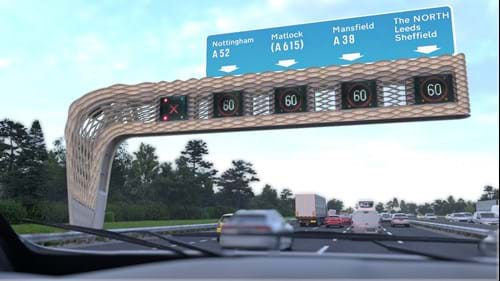
Commended schemes
Kevin Kelly Architects and Stand Engineers (G11)
This submission was commended by the Judging Panel for its incorporation and best proposed use of timber componentry.
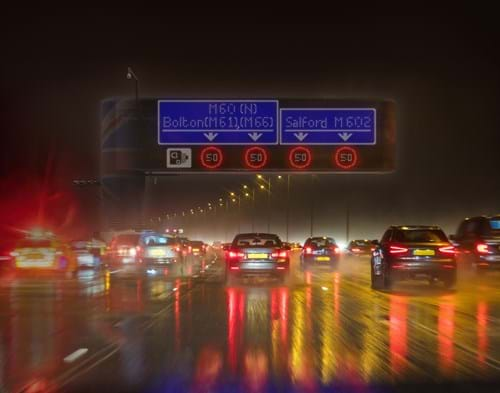
Hooman Talebi with Farshad Nasiri, Ehsan Masoud, Minoo Mashhadi, Raziyeh Rasapour, and Homa Farjadi (Design Advisor) (G50)
This submission was commended by the Judging Panel for its proposed use of digital screen technology to turn the gantry into a singular information-based object.
Knight Architects (G62)
This submission was commended by the Judging Panel for proposing the best challenge to the continued and future need for overhead gantry structures.
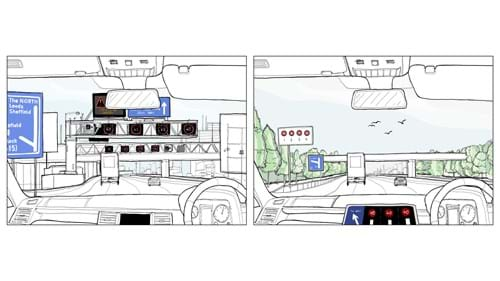
Notes to Editors
National Highways is the wholly government-owned company responsible for modernising, maintaining and operating England’s motorways and major A roads.
Real-time traffic information for England’s motorways and major A roads is available via the Traffic England website, local and national radio travel bulletins, electronic road signs and mobile apps. Local Twitter services are also available.
For further information please contact National Highways' press office (24hrs) on 0844 693 1448 and select the most appropriate option:
Option 1: National enquiries (9am to 5.30pm) and out of hours for urgent enquiriesOption 2: North West (9am to 5.30pm)Option 3: Yorkshire and North East (9am to 5.30pm)Option 4: West Midlands (9am to 5.30pm)Option 5: East Midlands (9am to 5.30pm)Option 6: East (9am to 5.30pm)Option 7: South East (9am to 5.30pm)Option 8: South West (9am to 5.30pm)
